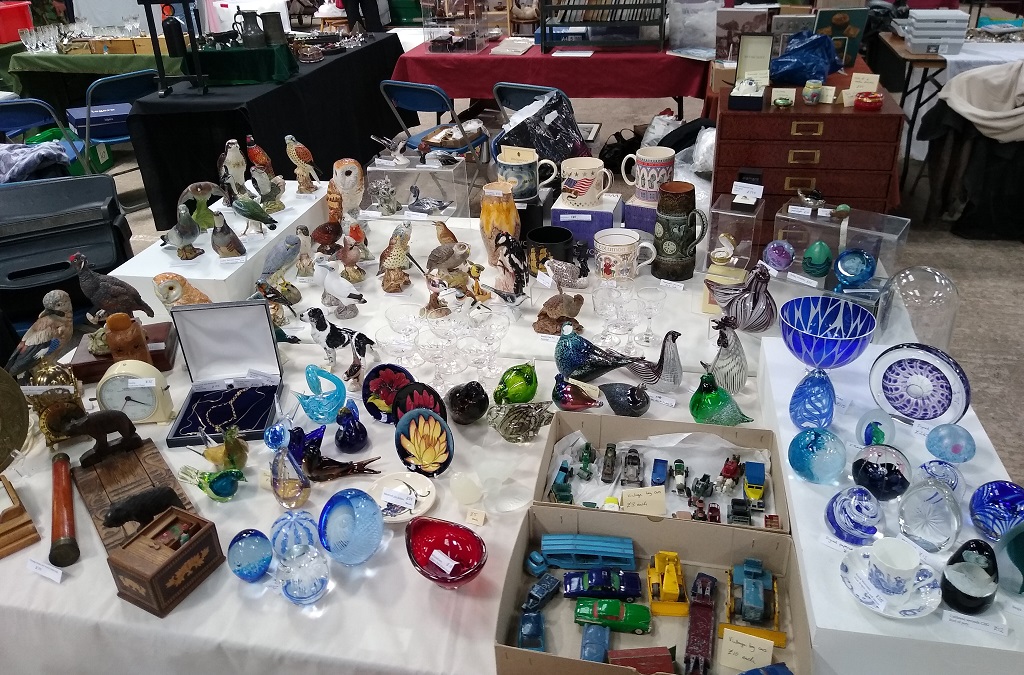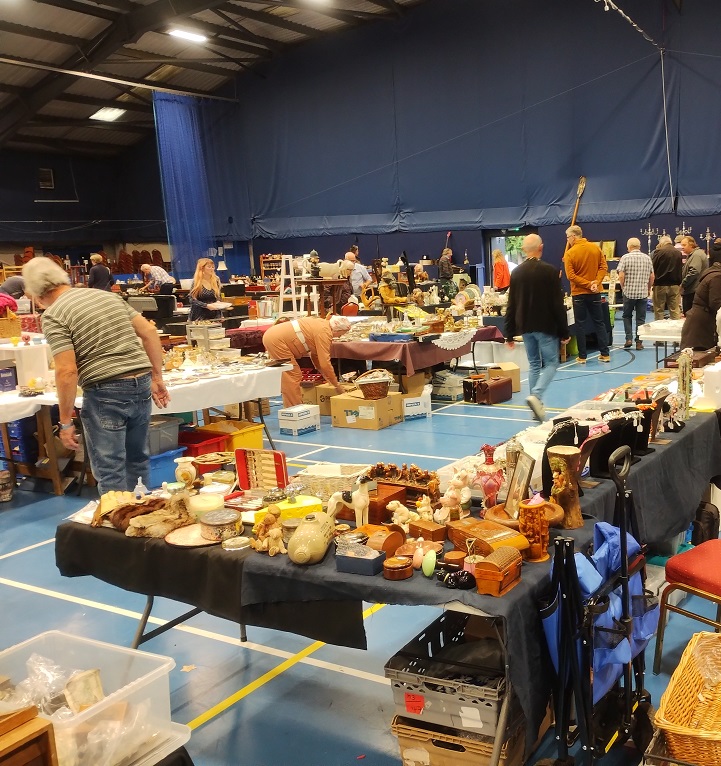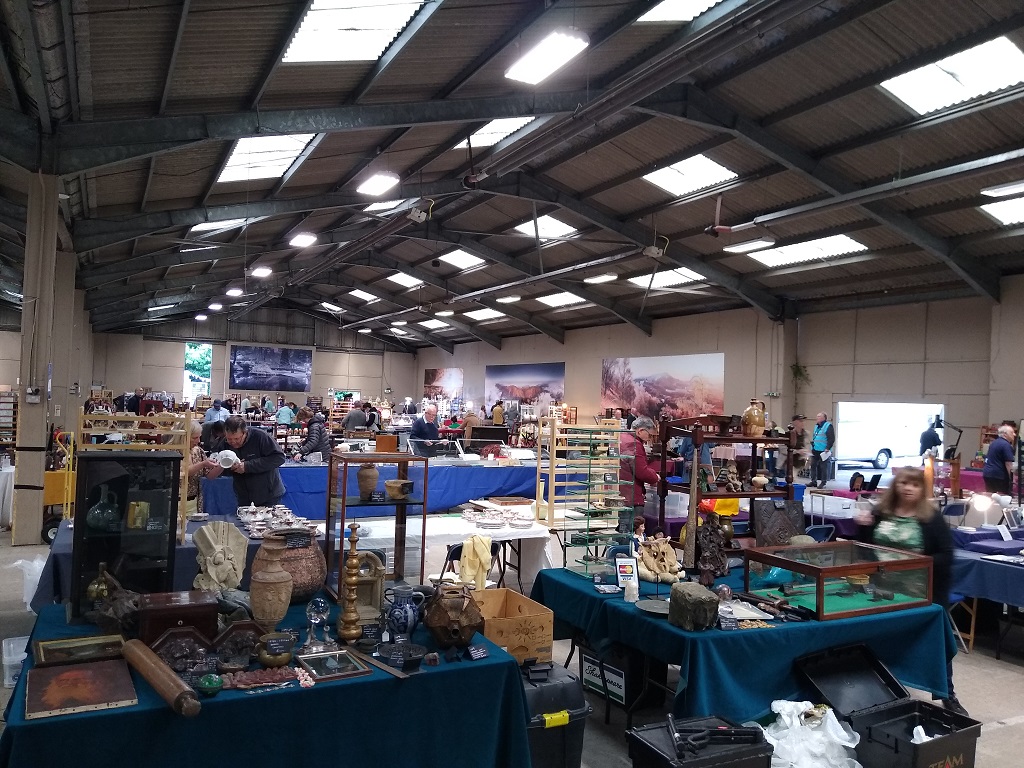In recent years I’ve sold art and antiques at quite a few fairs. In my professional life I had relatively little contact with people, so it’s been a steep learning curve. This seems to be a common theme for people who develop an interest in antiques, so If you’re the same, don’t worry, you’re not alone.
As a beginner, I’ve talked to lots of people about how to get get the best from the experience. I’ve also noticed it’s not uncommon to have conversations with people who are interested in selling at fairs but don’t know how to get started. There’s a lot to cover but don’t be put off. I’ll split it into a couple of postings but even so it will only be an introduction.
A bit of jargon
There’s an expression I’ll use which was new to me, but is clearly common in the business. When you attend a fair to sell, this is calling “standing”. So you can be said to “stand at the fair”. It’s a bit confusing because the place you “stand” is often called a stand, but sometimes a pitch. To make matters worse, where events have inside and outside selling a “pitch” might only refer to the outside areas and a “stand” the inside, but we’ll come to that later….
What brings you here?
Everyone has their own story to tell and everyone who stands at a fair starts out for their own reasons. However, I’d say the majority of people who ask me about getting started are doing so because they already have a house/garage/loft full on stuff they have accumulated and don’t know what to do with it.
The accumulation of items is sometimes from a single source, maybe an inheritance or a collection of items someone got bored with. Sometimes it’s a combination of things, a lifetime of accumulation followed by a decision to downsize after children have left home or following retirement.

Where ever you came by your items, if you think you have enough to fill a car (possibly several times over) you might fancy having a go at selling them at an antiques fair. However, before you do that you probably need to do some research on what you have.
What have you got to sell?
Some items will need specialist advice, but I’d always start with an Internet search. It’s very rare for someone to have a genuine one off item, unlike anything anyone has ever sold. So whatever it is, if you’re not sure of how to describe it, begin by looking for a maker’s name or mark and look that up. Failing that, even a vague search such as “small green glass duck” will often turn up something to give you a start.
If you’re looking at glass or jewellery in particular, I would invest in a Jeweller’s Loupe. These are a small magnifying lens, usually giving a 10x magnification. They are invaluable for reading hallmarks or artist’s signatures. They cost very little and if you’re a regular around the antiques world, having one to hand is really useful. It can also help to keeps sellers honest as you can check properly for things like signs of gold or silver plate wearing off or whether a picture is a print or an original.
Valuation: Things that help, things that hinder
This is a huge subject, so all I can do here is give a very brief introduction. You will learn with experience and no one gets this right all the time. But these pointers should get you started.
Anything with a maker’s mark or a signature is going to attract more attention that an unmarked item. Even if you can’t identify the artist or maker from a mark, someone buying it may fancy having a go. Signed items just shout “hand made” by someone who was proud of what they created. That’s the sort of thing buyers want.
Conversely, unsigned or unmarked items suggest volume produced items. Items that look like someone else’s style but aren’t marked are almost always going to be considered copies. If the item is obviously well made then it will have value in itself but probably not what you’d want.
“Condition is key” is a phrase you’ll hear a lot when selling almost anything. When you’re sorting through items, obvious damage will kill the value of most things, but reasonable wear is usually OK, and sometimes beneficial as it indicates genuine age. Be careful about discarding damaged items though. Before you throw out that old vase with a badly repaired rim, make sure you know what it is. The highest value items can still be worth something, even with damage especially if you think they have good age to them.
Some things, particularly wooden items, are very repairable. If damage is slight or superficial you might consider having a go yourself. The internet is full of really excellent videos from people who can show you how to do simple restoration work. Restoration is a subject that could fill many a blog page on it’s own. I’m very much a beginner, but I’ve managed a few satisfying repairs. The main thing is, before you start, to have an idea of what you want to achieve and don’t over restore. One of the commonest mistakes people make is to get the polish out to really shine up tarnished metal. That can kill the value of an item. If in doubt, get advice from an expert as to what’s best in terms of adding or retaining value.
Cracked, crazed or chipped ceramics usually lose most of their value. Only very special or very old pieces retain much value if damage is obvious. Better ceramics can be worth getting restored but the restoration is usually detectable and collectors will be wary of spending big. In general you shouldn’t try ceramics restoration yourself. The results are rarely better than awful.
Ceramics and glass respond well to gentle soap and water. It’s amazing the dirt you can get off them. Don’t over rub hand painted items, especially any gold paint, and dry gently. A light rub with a dry cloth can really make old glass shine. Don’t even think about the dishwasher… (although I do have a story about that, another time).
Wood shouldn’t be put anywhere near water unless you’re really careful. You can destroy wooden items in seconds with water. If you have to do some cleaning have a detailed read up first to identify what the surface finish is and what’s best to use. A common, traditional wood finish is shellac. Modern cleaning chemicals can also strip shellac in seconds. It can be repaired, but for your first go, you really don’t want to be having to try.
Seeking advice
Every auction house I know will offer free valuations, usually on a midweek morning or afternoon. They aren’t being generous here, it’s a key part of their business. You know the expression “If it’s free, you’re the product”? By offering free valuations it’s your items that the auctioneer hopes will become their product.
Don’t be intimidated by the experts at auction houses. Whatever items you take for valuation they will have seen far worse. Only occasionally will they see far better. They will give you an honest valuation and advice. You might be pleasantly surprised.
Of course, having had the advice you are free to try to sell the items yourself. Which brings us back to antiques fairs and the surprisingly difficult task of finding a suitable antiques fair.
Finding a fair to stand at
Antiques fairs come in all sorts of types and sizes. Some have hundreds of stands, some no more than a dozen or so. Some last for a few hours, some several days. You might be surprised to learn that some require you to set up the day before they open so that every item you’re offering for sale can be vetted by experts to check for authenticity. Clearly, it’s good to match your stock with the fair.
Before standing at a fair, do the rounds of a few that you think are close enough for you to travel to. There are some great websites that list fairs. In the UK antiquesatlas.com is probably the best. Most fairs run at weekends but you might have to be patient. Few fairs run more than once a month and many run only one or two times a year.
Sizing up a fair
When you start to visit fairs you will notice the different character of each event. Look at the stands and see what’s for sale. Don’t just look at the types of items but the quality. You don’t need to worry if your stock is different (that’s generally a good thing) but it should be of a similar standard to what’s already on offer. Always take time to talk to a few of the traders. They will almost always be happy to chat. The sort of questions to ask are:
- Have they stood at this fair before?
- How well is the fair doing in terms of footfall?
- How does it compare with other fairs in the area?
- How easy is parking/unloading/loading?

If I’m visiting a fair with a view to standing at a later date, I like to go towards the end of the day. Visitor numbers will have tailed off and so you can see how long that tail is. You can assume the first few hours are the busiest but two hours before the end, you don’t want to be the only buyer in the place.
Sizing up the space
All fairs will have an internet presence so you should know what a stand costs but by visiting you can see the stands, how they are laid out and what you get for your money. Tables are usually provided for indoor spaces and for a small charge you can usually have a second, even for a single stand. Outside, you usually have to bring your own but you get more space.
It might seem a bit counter-intuitive but indoors you want to see the stands fairly close together. This indicates a popular fair where the traders are keen to come, so the organisers have to pack stands in. An event with widely spaced stands probably indicates a fair that is struggling. You will be able to get a booking easily but it could be a bit of a poisoned chalice. The chances are it’s not the best of events for selling at.
Outdoors you can usually expect to get lots of space. Typically about twice the length of a large car or small van. You’ll normally have to bring your own tables and any weather protection, all of which eats into the space you have in your vehicle and adds to your set up time.
Find the organiser
Having had a look around, you should also be able to talk to the organisers. Be gentle. Running a fair is very hard work. The organisers were almost certainly setting up the afternoon or evening before, were up late taking last minute phone calls and emails. Almost certainly, they were up very early that morning. By mid-morning they will be flagging and if it’s into the afternoon they probably aren’t at their best. However, most will try to make you feel welcome and will be pleased to hear of your interest in their fair.
The crucial question you have to ask is about waiting lists. Some fairs can offer newcomers a place very easily, but the fairs with the best customer footfall will probably have a waiting list. I recently spoke to a trader who has been waiting list for 9 months to get a stand at a 300+ stand fair. I’m on the list too, but somewhere behind him. Just because a fair is big doesn’t mean they will have space for you (or me).
Comfort and the environment
Electricity
If you’re planning on selling anything that needs electricity (lighting being the most common), make sure you can see power being provided to each stand. This is pretty common for indoor events but not likely if you’re outside.
Don’t even think about taking a kettle or heater to plug in at your stall. High current devices are explicitly banned at most events on safety grounds.
Heating and lighting
If you’re in a cold country and the event is going to take place in winter, then check out what heating is available if being cold is a problem for you or your buyers. Standing around for 6 hours in a cold environment can be a challenge if you’re not used to it, and potential buyers will spend more time looking if they aren’t cold either. Have a look at the floor. A big venue may only have a concrete floor. This is fine is summer but in the UK, at least, you might want boots in winter if the room isn’t heated.

One that might not occur to you is to look at how much lighting is provided. Some big venues are quite poorly lit. In half light, it can be really hard to get your stock looking good. You might consider a bit of extra lighting for your stand. This is quite a common thing but don’t blind your buyers, so try to use down-lighting.
All still looking good?
If you’ve got this far, hopefully you’ve had a look at your stock and know what you want to sell and what it should be worth. You’ll have had a good look at a few fairs and will have an idea which ones look as if you and your stock will fit in. Hopefully, there will be at least one with some space available for you in the near future.
Not only that, with luck, having seen a few fairs, you’ll be more excited than ever about having at go at selling.
In the next posting, I’ll write about preparing for the big day and what to expect.